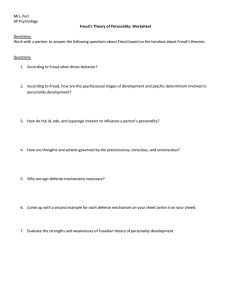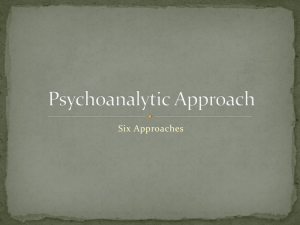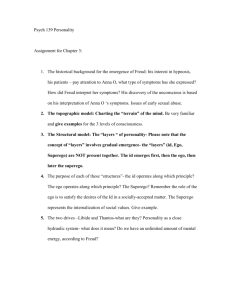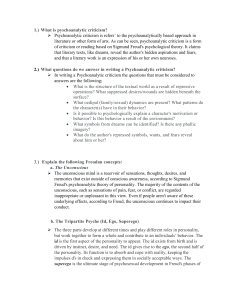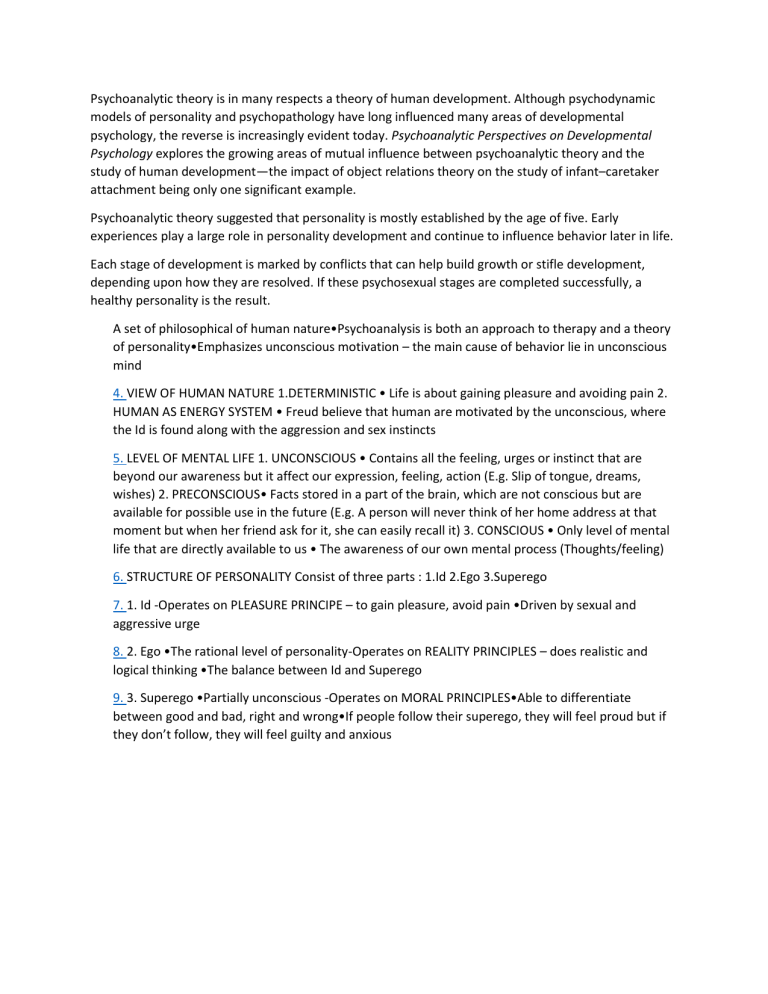
Psychoanalytic theory is in many respects a theory of human development. Although psychodynamic models of personality and psychopathology have long influenced many areas of developmental psychology, the reverse is increasingly evident today. Psychoanalytic Perspectives on Developmental Psychology explores the growing areas of mutual influence between psychoanalytic theory and the study of human development—the impact of object relations theory on the study of infant–caretaker attachment being only one significant example. Psychoanalytic theory suggested that personality is mostly established by the age of five. Early experiences play a large role in personality development and continue to influence behavior later in life. Each stage of development is marked by conflicts that can help build growth or stifle development, depending upon how they are resolved. If these psychosexual stages are completed successfully, a healthy personality is the result. A set of philosophical of human nature•Psychoanalysis is both an approach to therapy and a theory of personality•Emphasizes unconscious motivation – the main cause of behavior lie in unconscious mind 4. VIEW OF HUMAN NATURE 1.DETERMINISTIC • Life is about gaining pleasure and avoiding pain 2. HUMAN AS ENERGY SYSTEM • Freud believe that human are motivated by the unconscious, where the Id is found along with the aggression and sex instincts 5. LEVEL OF MENTAL LIFE 1. UNCONSCIOUS • Contains all the feeling, urges or instinct that are beyond our awareness but it affect our expression, feeling, action (E.g. Slip of tongue, dreams, wishes) 2. PRECONSCIOUS• Facts stored in a part of the brain, which are not conscious but are available for possible use in the future (E.g. A person will never think of her home address at that moment but when her friend ask for it, she can easily recall it) 3. CONSCIOUS • Only level of mental life that are directly available to us • The awareness of our own mental process (Thoughts/feeling) 6. STRUCTURE OF PERSONALITY Consist of three parts : 1.Id 2.Ego 3.Superego 7. 1. Id -Operates on PLEASURE PRINCIPE – to gain pleasure, avoid pain •Driven by sexual and aggressive urge 8. 2. Ego •The rational level of personality-Operates on REALITY PRINCIPLES – does realistic and logical thinking •The balance between Id and Superego 9. 3. Superego •Partially unconscious -Operates on MORAL PRINCIPLES•Able to differentiate between good and bad, right and wrong•If people follow their superego, they will feel proud but if they don’t follow, they will feel guilty and anxious and aggression. He thought people were motivated to satisfy their urges, and that much of development involved learning how to do so in socially acceptable ways. In addition, Freud believed that early experiences shaped later functioning, and he drew attention to childhood as an important precursor to adult behavior. Freud also promoted the idea that there was a vast, hidden reserve to our psyche, and what we consciously know about and experience is only the small tip of the iceberg of who we are. Sigmund Freud: Psychosexual Development Freud (1953, 1964a, 1964b) believed that people are born with biological drives that must be redirected to make it possible to live in society. He proposed three hypothetical parts of the personality: the id, the ego, and the superego. Newborns are governed by the id, which operates under the pleasure principle—the drive to seek immediate satisfaction of their needs and desires. When gratification is delayed, as it is when infants have to wait to be fed, they begin to see themselves as separate from the outside world. The ego, which represents reason, develops gradually during the first year or so of life and operates under the reality principle. The ego’s aim is to find realistic ways to gratify the id that are acceptable to the superego, which develops at about age 5 or 6. The superego includes the conscience and incorporates socially approved “shoulds” and “should nots” into the child’s value system. The superego is highly demanding; if its standards are not met, a child may feel guilty and anxious. The ego mediates between the impulses of the id and the demands of the superego. Freud proposed that personality forms through unconscious childhood conflicts between the inborn urges of the id and the requirements of civilized life. These conflicts occur in a sequence of five stages of psychosexual development (Table 2), in which sensual pleasure shifts from one body zone to another—from the mouth to the anus and then to the genitals. At each stage, the behavior that is the chief source of gratification (or frustration) changes—from feeding to elimination and eventually to sexual activity. Freud considered the first three stages to be crucial for personality development. According to Freud, if children receive too little or too much gratification in any of these stages, they are at risk of fixation, an arrest in development that can show up in adult personality. Babies whose needs are not met during the oral stage, when feeding is the main source of pleasure, may grow up to become nail-biters or smokers. A person who, as a toddler, had too-strict toilet training may be fixated at the anal stage, and be obsessively clean, rigidly tied to schedules and routines, or defiantly messy. According to Freud, a key event in psychosexual development occurs in the phallic stage of early childhood. Boys develop sexual attachment to their mothers, and girls to their fathers, and they have aggressive urges toward the same-sex parent, whom they regard as a rival. Freud called these developments the Oedipus and Electra complexes. Children eventually resolve their anxiety over these feelings by identifying with the same-sex parent and move into the latency stage of middle childhood, a period of relative emotional calm and intellectual and social exploration. They redirect their sexual energies into other pursuits, such as schoolwork, relationships, and hobbies. The genital stage, the final stage, lasts throughout adulthood. The sexual urges repressed during latency now resurface to flow in socially approved channels, which Freud defined as heterosexual relations with persons outside the family of origin. Freud’s theory made historic contributions and inspired a whole generation of followers, some of whom took psychoanalytic theory in new directions. Many of Freud’s ideas now are widely considered culturally biased or obsolete or are impossible to investigate scientifically. Psychoanalysts today reject his narrow emphasis on sexual and aggressive drives to the exclusion of other motives. Nevertheless, several of his central themes have “stood the test of time” (Westen, 1998, p. 334). Freud made us aware of the importance of unconscious thoughts, feelings, and motivations; the role of childhood experiences in forming personality; the ambivalence of emotional responses, the role of mental representations of the self and others in the establishment of intimate relationships; and the path of normal development from an immature, dependent state to a mature, interdependent state.


